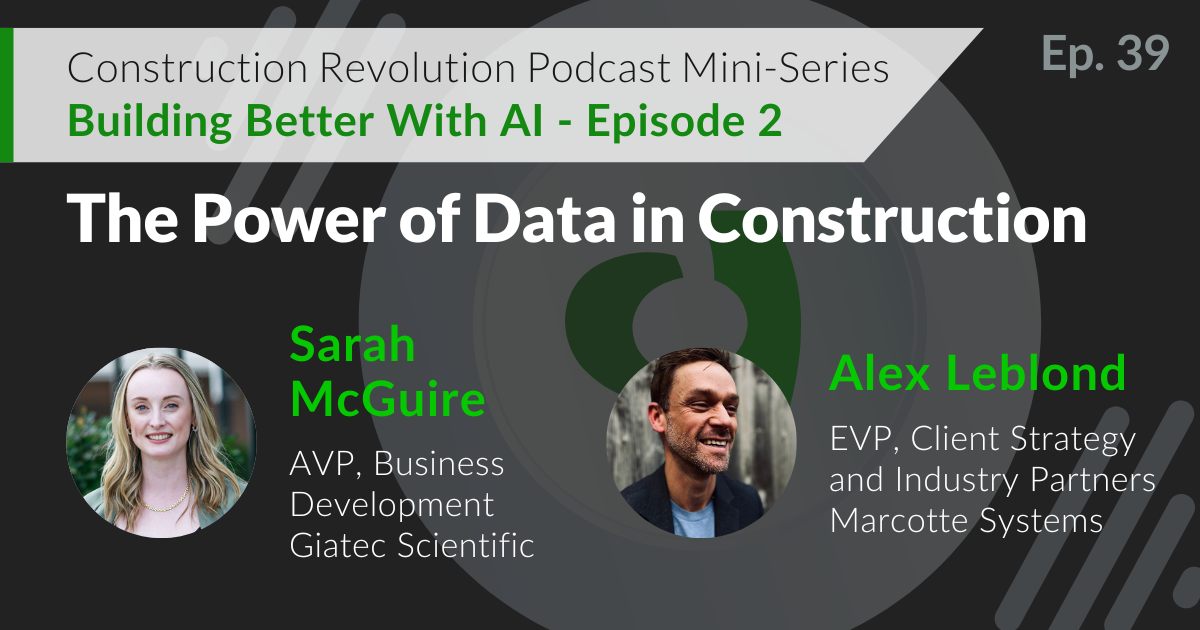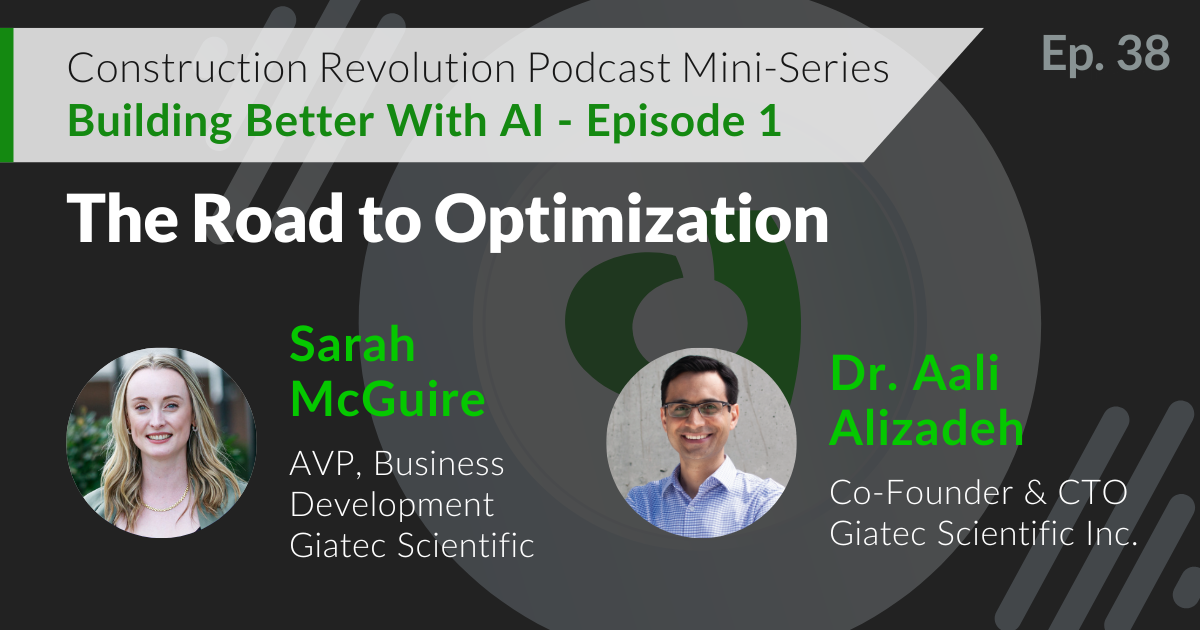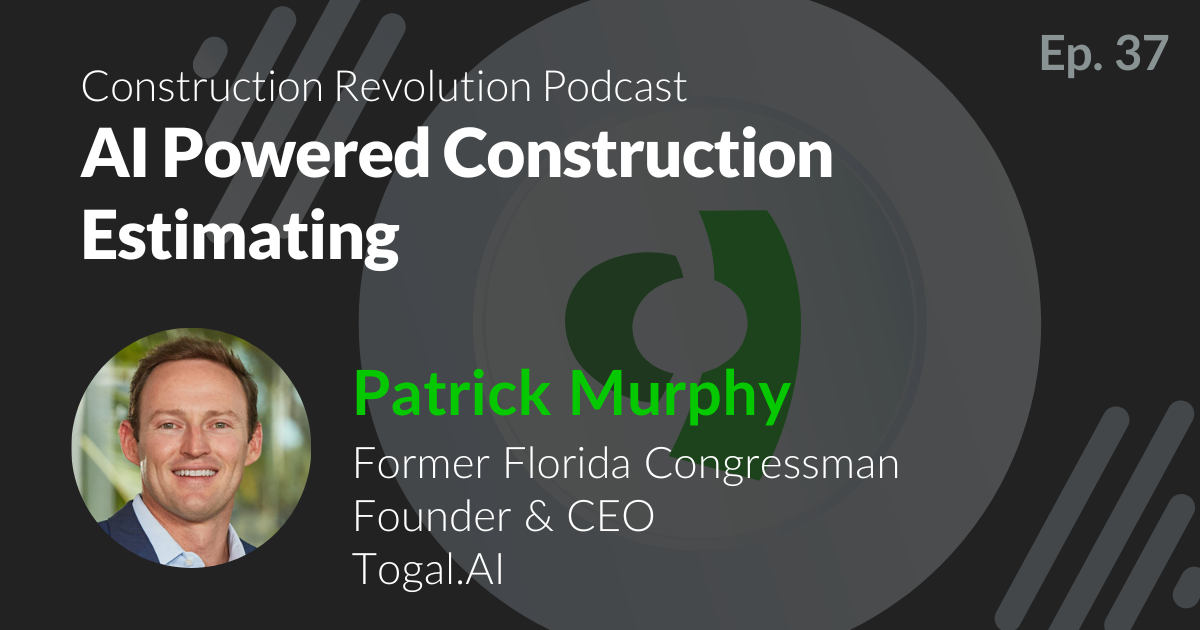
Episode 10 |
May 13, 2021
Solving the Construction Industry’s Problems Using Drone Technology
In This Episode
In this episode of Construction Revolution, we are joined by Jay Mulakala from DroneDeploy, where he leads the Global Solutions Engineering team in guiding enterprise sales strategies within North America and the APAC. Jay shares his insights on the potential of drone technology to enhance data visualization and analysis strategies, evolving from basic mapping techniques to a 360-degree experience as provided by their 360 Walkthrough feature, as well as optimizing the project management process in the construction industry. Jay also addresses safety concerns and regulations, relevant authorizations and clearance requirements, as well as emergency and evacuation plans pertaining to their drone operation.

Host
ERIC YEE
Content Marketing Manager, Giatec Scientific Inc.

Guest
JAY MULAKALA
Manager, Solutions Engineering, DroneDeploy
Podcast Transcript
Eric:
Hello there and welcome to the Construction Revolution Podcast. My name is Eric Yee and here on the show, we explore latest trends, technologies, people, and organizations that are revolutionizing or disrupting the construction industry and changing what the industry will look like tomorrow. Today on the show I’m speaking with Jay Mulakala from DroneDeploy. Jay manages a solutions engineering department at DroneDeploy, where he leads the global solutions engineering team, guiding enterprise sales strategy within North America and the APAC. His expertise spans across, but not limited to driving strategy around solution engineering functions and building thought leadership. Jay has worked within the product management and commercial UAV industry for over six years with customers within construction, mining, insurance, aerospace, and defense. So without further ado, let’s get to my interview with Jay Mulakala and learn a little bit more about how drones are revolutionizing construction sites all over the world.
So Jay, that, I mean, there seems to be a ton of potential use for drones in the construction industry from, you know, monitoring job sites to even like bridge repairs. Could you give our listeners some background on exactly what DroneDeploy is?
Jay:
Yeah, absolutely. At the end of the day at DroneDeploy, we’re really looking to drive enterprise data capture towards a single digital reconstruction solution. We started back in 2015 with one of our first customers, Brasfield & Gorrie, really focusing on exterior aerial reconstruction of their job sites. Beyond 2015, we realized our, a lot of our construction customers as well have value in gathering data sets from other sources. So for example, interior capture, as they’re building their residential or commercial properties, as well as much larger projects like civil construction projects of bridges, roads and highways. And so over the past several years, a lot of what our customers are using DroneDeploy for is to have that single reconstruction of their entire job site, whether that’s a bridge, whether that’s a freeway, whether that’s a smaller residential construction and being able to monitor the entire construction life cycle within one single solution.
And that means using DroneDeploy for looking at initial surveys, they can place the most accurate bids for their properties. Using drone technology and our processing engine for earthworks management and understanding how far along they are to completing their earthworks on their job site. And being able to get much more frequent surveys throughout that stage, so they know that they’re not running over budget or running beyond the schedule allocated for earthworks. And then during construction as well. Many of them could be working with hundreds of different subcontractors to lay groundwork, to lay pipeline, electrical lines, and being able to get a digital reconstruction of their project that’s easily accessible in the cloud anywhere in the world, especially in today’s environment where you can travel on to a job site, allows them to understand what the current state of the project is as well as be able to keep their subcontractors accountable for the work that they are doing.
Eric:
It seems like such a useful piece of technology that really, really stretches from the beginning of the project to the end of the project, and really answers a lot of questions and fixes a lot of many processes that people didn’t know that they even have the potential to do seven, eight years ago. So that’s actually one thing I wanted to ask you about, because I know before, DroneDeploy was kind of positioned as a drone mapping company, but now you guys are really kind of leading the way as an enterprise drone data company, not as a mapping company. Is that what you kind of mentioned in terms of gathering all that data from all those aspects of the life cycle of a project?
Jay:
Yeah, absolutely. Drone mapping is still a big use case today and something, a lot of our customers, even in different industries use DroneDeploy for. But as we’ve grown in the industry, as we’ve learned from construction customers, being more of a holistic solution for them to manage their job site in a very visual way, the same way we see the world with our own eyes is much more beneficial to them than just the maps and models.
And the same goes for when you’re working on larger commercial construction projects. Once you go inside, once you’re starting to build out the interior of a project, aerial drones alone, aren’t able to capture the data that they need to continue to monitor the job site. And that’s where some of the technologies we’ve released over the past few years, like partnering with Brasfield & Gorrie to capture 360 video inside of a property, allows them to continue to use DroneDeploy in a single platform without having to switch between different tools. And so we use the word drone very loosely. We’re not talking about drones in general, we’re talking about any robots that help you automate a data capture or data analysis. And that includes aerial drones, that includes ground-based rovers. That includes fully automated robots that you may be using on your job site.
Eric:
So DroneDeploy is really the, I guess, maybe data collection platform in the eyes that all these different inputs kind of use, correct?
Jay:
Even beyond data collection itself, one of the main pieces on data collection that we support today is aerial data capture using drones. One of the big pushes we’re going in the direction of is we want to be able to provide a platform that our customers can use to bring in whatever data sets they have, whatever data sources they have into DroneDeploy so that they can visualize that all on one platform. And that can be drone data, that could be individual photos, that could be videos that they’ve captured, that can be helmet cams that they’re using to document their job site. We’re not going to be able to offer a data collection solution for every single one of them, but we are looking to offer the inspection tools, the annotation tools and measurement tools, and specifically the collaboration tools so that they can visualize all that data in one reconstruction of their site, and then be able to generate reports or make decisions based off that data set.
Eric:
Perfect. It’s yeah, it seems really powerful. So something like maybe the helmet cams, would they then take that file off of the helmet cams? So that means like a GoPro or something and upload that into the DroneDeploy platform?
Jay:
Yeah. So today we’ve got customers using a variety of different tools. They may be even just be capturing photos using their phone. A lot of customers recently since about 360 Walkthrough’s release have been using 360 cameras as well.
Eric:
Makes sense.
Jay:
And of course, capturing simple video using a GoPro or other cameras, DSLRs that you might be using on their job site, they can upload that and adjust that within DroneDeploy as well. For some of them, we’ve got easy integrations directly into DroneDeploy, so it takes away a few of those steps. For others, wherever that data source is, you can certainly take that from the SD card and upload that to DroneDeploy, to have that alongside all the other data sets from your site.
Eric:
Could you maybe give me an example of maybe a customer case or a use case where someone took a lot… they have all this different data in DroneDeploy and maybe integrations with other platforms that you’re integrated with and how they kind of derive some insights or value from it?
Jay:
Yeah, absolutely. Today, we see a lot of project management teams, as well as engineering and surveyors using DroneDeploy more as a holistic product. And we released a few integrations specifically for those users over the past few years. One is our Procore integration. We’ve learned from a lot of our customers, they’re using Procore today for project management. And the other is directly with Autodesk BIM 360 where some of the other project teams, or even engineers will use to access some of their architectural drawings, design plans, or other files that they’ve generated for that particular site.
And so using those integrations today, like our project management organizations, for example, they’re able to capture the realistic 3D representation of their job site entirely, within DroneDeploy, they’re able to identify those issues within DroneDeploy. And those issues are then integrated back into their project management software like Procore where the project teams can use that information to aggregate all the issues that have been identified, assign owners to go in and resolve those issues and be able to track the status of those issues seamlessly between the two platforms.
So it’s not a one or the other solution. It simply means within Procore, they’re able to go in and manage a lot of those issues in real time. And they still have the snapshot of the data capture from that particular day, at that moment in time that they can use to refer back to not only the 3D model, but also take a look at the individual photos, take a look at the individual inspections that were conducted on the ground in a very visual sense within DroneDeploy.
Eric:
That’s exciting, because I know a lot of the times I hear the anecdote that the construction industry is maybe a laggard in terms of adopting new technology. But thinking of just these drones flying on construction sites, creating maps, grabbing all this data and then having some kind of project management tool to refer to all this, like Procore, and it really does sound like this industry is really shifting rapidly in terms of the adoption of this technology. Obviously there was a lot of potential gains in terms of data collection, but are you seeing construction site owners realizing potentially time savings and cost savings by implementing DroneDeploy?
Jay:
Yeah, absolutely. As you can imagine, within construction, regardless of what stage you’re in, being able to gain a better understanding of what the project timetables are and sticking to those timetables are absolutely critical, not only for delivering it to the owner on time, but also ensuring that those projects don’t succumb to cost overruns, but also just safety.
There’s a lot of moving parts and a lot of projects that are on accelerated timelines. And you want to ensure that your people onsite are as safe as possible. And so using technologies like DroneDeploy as well as other hardware and software solutions, one, customers are able to get that time efficiency. So for example, like the earthwork stage that I mentioned earlier, it means that they can go out and conduct a drone survey on a daily basis in a matter of minutes. And they’re able to know whether they’ve hit their excavation targets for that day, or if they were slower than usual or faster than usual. And they can adjust their timelines accordingly, as opposed to what they may have done in the past where they’d have to hire a surveyor to come out and lay down points on the job site, stop the site completely for safety reasons, and then go out and survey those points to identify where they are at, at that moment in time.
Or the alternative of not doing those surveys throughout the earthwork stage and waiting until the very end to understand that they’re a week, two weeks, three weeks, a few months behind schedule, and now having to frantically go back and readjust their timelines after those issues have already occurred.
And so speed of data capture and the speed of data visualization has been huge for them to minimize those costs and minimize delays in the project. And then of course safety. They, for a lot of these fast-moving sites, especially where they’re working with a lot of different subcontractors, there’s a lot of moving parts on these sites. And so having drone data at that particular moment in time also means that they have an audit record and an audit trail of what happened on that particular day. Are people following safety protocols that have been identified for that job site, as well as identify if there’s any safety issues that might arise later down the line. Because of improper placement of underground electrical lines or not constructing something according to design that could cause safety issues later in the project.
Eric:
You mentioned safety. I know there’s a lot of controversy over drones 10 years ago with regulations as well as just the different safety in terms of how pilots kind of operate them. But DroneDeploy has several steps in place to kind of help with pilot safety, correct?
Jay:
Absolutely. Piloting drones today are much easier than they’ve been in years past, and as a pilot myself, I’ve crashed my number of drones in the past. And it’s incredibly difficult, even from us as a software provider today, for us to even crash drones. The hardware itself has come a long way, but on top of that, we truly believe that using the DroneDeploy platform, that our customers can use drone technology to capture data themselves. They do not have to be a very proficient pilot. They do not have to understand all the rules and regulations.
We provide a lot of that information upfront within our flight application, like our LAANC authorization that allows users to be able to see local airspace regulations and request clearance, if they need to, in that particular area. We also have additional safety precautions in the app itself that restricts users from flying in unsafe conditions, or just having the information available for them to be an intelligent pilot when they go out on site. And that’s the mission that DroneDeploy has always moved towards. We believe that we can train an average user in a matter of a few hours on how to go out and start capturing data with DroneDeploy, reliably, safely and efficiently without having to go through an extensive training program to learn how to pilot these aircraft. At the end of the day, it’s a tool in your toolbox.
It’s like having a hammer that you need to use and drones shouldn’t be complicated. And we want to make sure we automate and make that as easy as possible within the platform. So that you don’t have to think about how to pilot a drone or if you can fly here, but you can go back to your day job as a project manager, as a surveyor and help you be more efficient in doing your daily duties.
Eric:
Guess as a supervisor, a surveyor, would they go in, procure their own drones and then contact you at DroneDeploy to get them all set up? And is that how it works, then they start going off and piling themselves?
Jay:
Yeah, it’s, it’s a mix today. We have a lot of customers who have started experimenting with drone technology and they approach us when they’re looking to scale out their programs. Maybe it’s an individual surveyor with some hardware in the Department of Surveyor license today. In other cases, we have project managers and CIOs and IT teams that are looking at how they can efficiently use emerging technologies on their job sites. And so they’re more relatively new to drone technology in general. And for every single one of our customers that come to DroneDeploy, we and my team specifically, really works with the customer to identify where they are at in their drone program maturity so that we can tailor our conversations to help them get the most of that, not only DroneDeploy, but leveraging drone technology.
And at the end of the day, our product is our enterprise cloud platform in addition to our mobile app and our service offerings. But we understand that a lot of our customers are going to be coming to us asking us about what hardware should they use.
Eric:
For sure.
Jay:
What kind of certifications do they need to get? How do they get a pilot certified and how do they really scale out their drone program operations? And how do they think about pre-flight checklists and safety protocols? What are their emergency response procedures if there is an issue? And we’ll work with them to help address a lot of those concerns, because at the end of the day, we know that if they’re successful in building and scaling out their drone program, that they’ll be a successful customer of DroneDeploy’s.
Eric:
Do you have a particular favorite project that you’ve seen DroneDeploy apply it on or a particular use case that maybe surprised you with how a customer used it for?
Jay:
I’d say that that happens almost on a daily basis. We’ve got a channel internally at DroneDeploy called Great Maps, where a lot of internal employees may share examples of how our customers are using drone data. And it’s not uncommon to find new use cases that our customers have started using DroneDeploy for that we may have never even imagined. And we learn a lot from them as much as they learn about us, about how they can leverage this data. Even when we released 360 Walkthroughs about a year ago at a DroneDeploy conference we initially released that intentionally for our construction customers who are working on much larger commercial properties for interior inspections. But since then, we’ve had customers come to us and start using that technology for grapevine inspections in a large field. We’ve had others use 360 cameras to go and capture data in areas where airspace might be restricted.
They’re flying right near an airport, or they need to capture data at an airport. So they’re able to use DroneDeploy with 360 cameras to capture that data. And in other cases, we have a .org arm of DroneDeploy as well that helps a lot of other non-profits capture value using DroneDeploy. And one of the common ones or one of the more profound ones I learned about a few years ago during the California fires, especially the campfire out here in Northern California, that affected Paradise, California. We worked with the Menlo Park Fire department for them to go out and map the entire town of Paradise, California within 24 hours. We then processed that data into a large map for them within another 24 hours, and within 48 hours we then captioned that data. The fire department now has a strong understanding of what the current state of Paradise, California looks like.
A team was able to identify what the extent of the damage is and plan out their evacuations and emergency response precautions. And it was also useful tool for homeowners. We had homeowners contacting us to get access to that data, because it meant that they could, if their house was damaged without them having to go back and travel to Paradise California, they can submit that information to their insurance company to be able to file a claim and be able to address that claim without having to relive some of the experience and trauma that they may have endured escaping those fires. So that was just an interesting example of one where we’ve seen other municipalities and fire departments use DroneDeploy over the years. And in California, it’s a common use case for them to use DroneDeploy for vegetation assessments and vegetation management, identify fire lines for safety precautions. And of course use as post-fire as well to identify the extent of the damage of a recent fire.
Eric:
So that’s all under the… This is the Drones For Good initiative. Is that what you’re busy around?
Jay:
Yes.
Eric:
So if someone wanted to reach out to participate in that initiative, what will they do?
Jay:
Yeah, shoot us a message. If you, go to, reach out to us via any of our channels, you’ll be connected with our… one of our co-founders and customer success officer, Jono Millin, who’s driving our .org initiative. And he’d be happy, he and the .org team at DroneDeploy would be happy to work with you to identify what we can do to help you out in that situation.
Eric:
So that’s perfect. I have one last question, Jay. I’ll pull the trigger because I know you’re a busy guy. If I was say a general contractor that hasn’t started in using drones before, but I see so my competitors using them and I want to get started, what’s the first step that I should take to, you know, start working with DroneDeploy?
Jay:
Yeah, absolutely. First and foremost, I’d say, do reach out to us. At the end of day, like I mentioned, we want to make sure that you’re successful and there can be a lot to learn, especially from day one, if you’re just getting started in the industry. We’ve released a lot of content online as well about how some of our customers are leveraging drone technology in addition to DroneDeploy on their job sites. One common story that we have at our job site, on our website is Brasfield & Gorrie, who’s been using DroneDeploy since 2015 and has been using DroneDeploy for aerial inspections, vertical facade inspections, for interior capture using the Spot robot and the 360 camera. And it could be a great way for you just to identify different ways that you can use drone technology that you may not have thought about before.
And it’s not uncommon for you to learn. As we go through that conversation, a lot of our customers come to us initially, just thinking they can use drones for simple photos and video capture, and they end up leaving our conversations, having a deeper understanding of how aerial maps and models can help them throughout the different stages of the construction life cycle, but also some of the different tools, reporting and integrations that we offer that allow them to continue to extend their workflow beyond just DroneDeploy in and of itself.
Eric:
Oh, that’s excellent. Well, Jay, thank you so much for your time. I appreciate you coming on the show quite a bit. Thank you.
Jay:
Absolutely. Thank you for having me, yeah.
Other Related Episodes
Episode 39 |
April 4, 2024
The Power of Data in Construction
In the second episode of our “Building Better with AI” mini-series, host Sarah McGuire explores “The Power of Data in Construction” with Alex Leblond, EVP Client Strategy and Industry Partners of Marcotte. Join Sarah and Alex as they delve into the dynamic world of construction data, unravelling the complexities of on-premises systems and shedding light on the industry’s journey toward technological advancement. Gain valuable insights into the challenges of acquiring and processing data and discover how innovative solutions are reshaping traditional practices. Guided by Alex’s extensive experience at Marcotte, this episode offers a comprehensive exploration of the past, present, and future of data in construction. From discussing the evolution of batching systems to the transformative potential of AI, this conversation delves into the pivotal role of data in driving efficiency, sustainability, and profitability. Don’t miss this enlightening episode as we continue our mission to build better with AI!
PLAY
Episode 38 |
March 21, 2024
In this thrilling debut episode of our “Building Better with AI” mini-series, dive into the dynamic world of concrete innovation with the visionary Co-Founder and CTO of Giatec, Aali Alizadeh, Ph.D. Dr. Alizadeh shares captivating insights into the challenges facing the concrete industry and how Giatec® SmartMix™ offers transformative solutions. From tackling overdesign to breaking down data silos, discover how SmartMix is reshaping concrete management practices with its cutting-edge AI technology. Join host Sarah McGuire as she delves into the narrative behind SmartMix’s groundbreaking journey, uncovering its revolutionary impact on concrete mix management and optimization. This is just the beginning! Stay tuned for exciting insights into the future of construction as we tease upcoming episodes that promise to push the boundaries of innovation even further. Listen in now and join us as we embark on a thrilling journey to build better with AI! Ready to unlock your concrete advantage? Learn more about SmartMix.
PLAY
Episode 37 |
February 1, 2024
AI Powered Construction Estimating
In this episode of The Construction Revolution Podcast, we are joined by Patrick Murphy, Founder of Togal.AI, and former Florida congressman. Patrick brings a unique blend of political insight, construction industry experience, and tech entrepreneurship to the table. Join host Steven Rossi as he explores Patrick’s extensive background in melding the worlds of construction and advanced AI technology, particularly in the field of AI-driven estimating. Discover how Patrick’s journey from the construction site to the halls of Congress and back to tech entrepreneurship is redefining construction estimating. Don't miss this episode to gain valuable insights into the future of AI in construction and why Patrick’s unique blend of experiences makes this a must-listen for anyone interested in the cutting edge of building technology.
PLAY
Want to Be a Guest Speaker, Sponsor, or Just Have a Question for Us? Fill In the Form!




